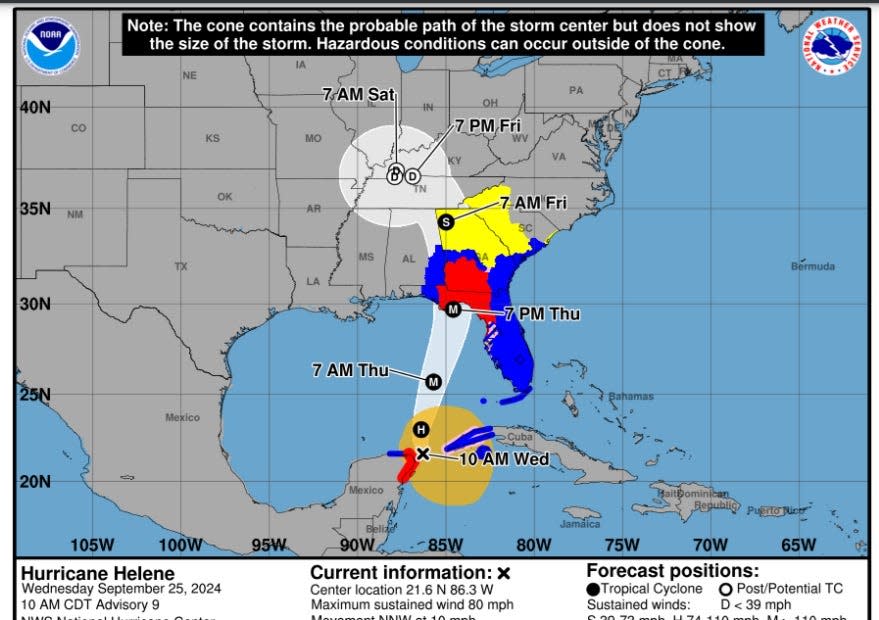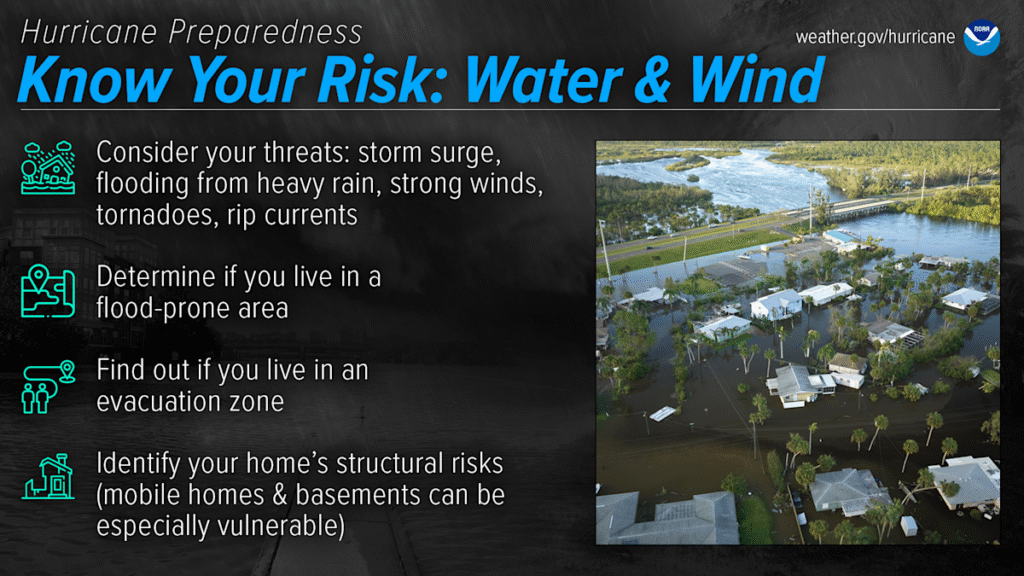The official start date of the 2025 Atlantic hurricane season is less than a month away.
Every year, no matter what the predictions are, forecasters urge residents to prepare early for hurricanes, not to wait until a storm is approaching. “It only takes one” is the warning cry.
To raise awareness about the dangers posed by hurricanes and tropical storms — it’s not just about the wind — and encourage people to prepare early for storms, the National Hurricane Center and National Weather Service have established May 4-10 as Hurricane Preparedness Week.
➤ Weather alerts via text: Sign up to get updates about current storms and weather events by location
The week covers various topics each day, providing valuable information for those new to hurricanes and good reminders to seasoned Florida residents.
Early predictions are for a “volatile hurricane” season in 2025, with above-normal activity.
Colorado State University forecasters ranked Florida No. 1 when it comes to the probability of a named storm coming within 50 miles, at 92%.
When is hurricane season?
The Atlantic hurricane season runs from June 1 through Nov. 30.
The National Hurricane Center will begin issuing tropical outlooks on May 15, highlighting any tropical disturbances showing potential for development.
2025 hurricane season predictions
The National Hurricane Center will release its predictions for the 2025 hurricane season later this month. Early forecasts released so far predict:
AccuWeather: Predicting 2025 could be a year with “volatile hurricanes” and warns storms could rapidly intensify shortly before making landfall.
Colorado State University: Season will be above normal. Florida ranked No. 1 when it came to the probability of a named storm coming within 50 miles, at 92%.
WeatherTiger: Dr. Ryan Truchelut, chief meteorologist with WeatherTiger, said 2025 has a “50-50 shot of landing in the ranges of”:
Hurricane Preparedness Week: See topics by day
Hurricane Preparedness Week 2025 is scheduled for May 4-10, focusing on a different topic each day. Here’s the lineup:
May 4: Know your risk: Water and wind
The first step of preparing for hurricanes is to know your risk. Find out today what types of water and wind hazards could happen where you live.
“Find out today what types of wind and water hazards could happen where you live,” NOAA said.
“Hurricanes are not just a coastal problem. Impacts from wind and water can be felt hundreds of miles inland, and significant impacts can occur regardless of the storm’s strength. Know if you live in an area prone to flooding, if you live in an evacuation zone, and identify any structural weaknesses in your home.”
NHC cone of uncertainty changes reflect how far storm impacts can be felt

Another change is coming to the National Hurricane Center’s map for the 2025 hurricane season.
In 2025, the National Hurricane Center experimented with its cone of uncertainty: tropical storm and hurricane watches and warnings were expanded to include interior counties. Previously, those watches and warnings were only shown on NHC maps for coastal counties.
The change came to show impacts from a tropical storm or hurricane can be felt far from where it makes landfall and well away from the coast.
Based on feedback on the experimental cone, in 2025 the National Hurricane Center said it will add a specific symbol this year — diagonal pink and blue lines — for counties where both a hurricane watch and tropical storm warning are in effect.
What are the main dangers from tropical cyclones?
Don’t get confused by the phrasing. Tropical cyclones is the generic phrase for tropical depressions, tropical storms and hurricanes.
The greatest threats to life and property from tropical cyclones are:
-
inland flooding from heavy rains
-
high surf and rip currents
Here’s a look at each of the threats:
Storm surge brings the largest loss of life in hurricanes
Storm surge is the water pushed toward shore by winds associated with a tropical cyclone.
Historically, storm surge “has caused the largest loss of life in hurricanes.”
Storm surge can:
-
cause severe flooding in coastal areas, submerging entire areas
-
cause structural damage to buildings
Storm surge is not limited coastal areas. “Storm surge can travel several miles inland, especially along bays, rivers, and estuaries,” NOAA said.
Flooding can make travel, evacuations difficult, deadly
Different from storm surge, flooding is caused by “extreme amounts of rain a hurricane can bring.”
The rain can be either over an extended period of time or caused by a short-term deluge.
Dangers from flooding include:
-
Homes and businesses could flood
-
Flooded roads could make travel and evacuations difficult
-
Potentially deadly hazard to those in vehicles or on foot
-
Floodwaters may contain harmful bacteria, chemicals, wildlife and other dangerous objects
“Extreme rain from hurricanes can even flood areas that aren’t normally prone to flooding. Flooding can happen hundreds of miles inland, and can persist for several days after a storm,” the NHC said.
Hurricane-force winds can bring widespread damage, power outages
There’s a human tendency to focus on maximum sustained winds as a hurricane approaches landfall, although the National Hurricane Center does issue warnings on expected storm surge and rainfall.
“Hurricane-force winds can cause damage to homes and other buildings, ranging from moderate to catastrophic depending on both wind speed and structural integrity.
“Wind damage can lead to large areas with power and communications outages, as well as uproot trees and make roads impassable due to debris. Signs, roofing material, and other items left outside can become flying missiles during hurricanes.
“Mobile homes are especially vulnerable to wind damage.”
Tropical storms, hurricanes can spawn tornadoes
Both hurricanes and tropical storms also can produce tornadoes.
“These tornadoes most often occur in thunderstorms embedded in rain bands well away from the center of the hurricane; however, they can also occur near the eyewall,” the National Hurricane Center said.
That fact hit Florida residents hard in 2024 with Hurricane Milton, which spawned at least 41 tornadoes before it made landfall in Siesta Key on Oct. 9.
Storms in its outer bands hit South Florida — the hurricane was in the Gulf — and the east coast of Florida more than 16 hours ahead of landfall. Tornadoes killed at least 15 people, including six in St. Lucie County.
Rip currents, surf deadly even when storm is far away
“Waves from distant storms can produce deadly rip currents and rough surf on beaches very far away,” the National Hurricane Center said.
“Good weather at the beach itself does NOT mean the ocean is safe. Even storms more than 1,000 miles away can cause impacts.”
Do you live in a flood-prone area? Here’s how to find out
If you live in a flood-prone area, you’re especially vulnerable to hurricane impacts.
However, remember that even it you don’t live in a flood-prone area, you’re not necessarily safe since extreme rain can flood even those areas.
Here’s how to find out now the flood risk for your area so you can plan accordingly.
-
Scroll down and enter your zip code and click on Discover Your Risk
-
Look at the map to see if your risk is low, moderate or high
-
You can also enter your address for a more precise view of your risk
-
You can also check NOAA’s Coastal Flood Exposure Mapper at coast.noaa.gov. Zoom in on the map to see a coastal flood hazard composite showing zones 1 to 11.
Do you live in a Florida evacuation zone? Here’s how to find out now
Determine now if you live in a storm surge evacuation zone. Here’s how to find your zone:
-
In the top left corner, enter your address
-
In the left column you’ll see your evacuation zone
Typically, Zone A is the most vulnerable and most likely to be evacuated first. Zone F is most likely to be evacuated last.
Hurricane season 2025 names
Here are the names for the 2025 Atlantic hurricane season, along with how to pronounce them:
Stay informed. Get weather alerts via text
What’s next?
We will continue to update our tropical weather coverage as conditions warrant and daily beginning May 15. Download your local site’s app to ensure you’re always connected to the news. And subscribe here.
Contributor: Dinah Voyles Pulver, USA Today
This article originally appeared on Naples Daily News: 2025 hurricane season: Preparedness Week starts with knowing risks
Read the full article here


